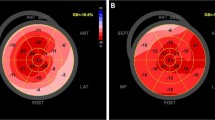Summary
In patients with acute or chronic myocarditis, arrhythmias are a common and often the only clinical symptom in the natural course of the disease. The potentially malignant tachy- and bradyarrhythmias are of particular significance in the differential diagnosis of sudden cardiac death in myocarditis. Factors responsible for the increased incidence of cardiac arrhythmias are structural changes, parameters of ventricular dynamics and vascular changes. On the one hand, inflammatory processes in the cardiac myocytes and interstitium can lead directly to fluctuations in membrane potential. Fibrosis and scarring of the myocardial tissue and secondary hypertrophy and atrophy of the myocytes favor the development of ectopic pacemakers, late potentials and reentry as a result of inhomogeneous stimulus conduction. Furthermore, parameters of ventricular dynamics such as increased wall tension, increased myocardial oxygen consumption and diminished coronary reserve in the case of disturbed systolic or diastolic left ventricular function also contribute to the increased incidence of arrhythmias. Lastly, vascular factors can further increase the arrhythmogenicity of the inflamed myocardium through the disturbance of micro- and macrovascular perfusion and the resulting myocardial ischemia. Non-invasive rhythmological evaluation by 24 h Holter ECG, measurement of ventricular late potentials and heart rate variability can be used for orienting risk stratification of the at-risk patient with myocarditis. Programmed atrial and ventricular electrophysiological stimulation also has a relatively high predictive value for spontaneous ventricular tachyarrhythmias. It should be emphasized that, at the present time, optimal electrophysiological parameters with a high predictive value do not exist. In a selected patient population, immunosuppressive therapy in addition to conventional antiarrhythmic therapy can lead to the reduction or complete suppression of spontaneous and inducible arrhythmias. Nevertheless, in the interim, further precautionary antiarrhythmic measures such as serial antiarrhythmic treatment, VT ablation and AICD implantation are necessary in patients with malignant cardiac arrhythmias. Right ventricular myocardial biopsy for demonstration or exclusion of myocarditis is an important additional examination which can improve the differential diagnosis and treatment of patients with cardiac arrhythmias of unclear etiology.
Zusammenfassung
Bei Patienten mit akuter oder chronischer Entzündung des Herzmuskels stellen Herzrhythmusstörungen im natürlichen Verlauf ein häufiges, gelegentlich das einzige klinisch faßbare Symptom dar. Den potentiell malignen tachykarden und bradykarden Arrhythmieformen kommt in der Differentialdiagnose des plötzlichen Herztodes bei der Myokarditis besondere Bedeutung zu. Für die erhöhte Inzidenz von Herzrhythmusstörungen sind strukturelle, ventrikel-dynamische und vaskuläre Faktoren verantwortlich zu machen. Zum einen können direkt entzündliche Vorgänge an den Herzmuskelzellen und dem Interstitium Membranpotentialschwankungen hervorrufen. Die Ausbildung von Fibrose und Narben im Herzmuskelgewebe sowie eine sekundäre Entwicklung von Hypertrophie und Atrophie der Herzmuskelzellen begünstigen die Entstehung von ektopen Automatiezentren, Spätpotentialen und Kreiserregungen durch eine inhomogene Erregungsleitung. Zusätzlich beeinflussen ventrikeldynamische Größen wie die erhöhte Wandspannung, ein erhöhter myokardialer Sauerstoffverbrauch sowie die erniedrigte Koronarreserve bei Vorliegen einer systolischen und/oder diastolischen Funktionsstörung des linken Ventrikels die erhöhte Inzidenz von Arrhythmien. Darüber hinaus können vaskuläre Faktoren durch eine begleitende mikro- bzw. makrovaskulär bedingte Perfusionsstörung mit konsekutiver Myokardischämie die Arrhythmogenität des entzündeten Myokards weiter steigern. Eine Risikostratifizierung des gefährdeten Patienten mit Myokarditis gelingt orientierend durch eine nichtinvasive rhythmologische Abklärung mittels 24-h-Holter-EKG, Messung der ventrikulären Spätpotentiale und der Herzfrequenzvariabilität. Einen vergleichsweise hohen prädiktiven Wert in Hinblick auf spontane ventrikuläre Tachyarrhythmien ermöglicht darüber hinaus die Durchführung einer programmierten atrialen und ventrikulären elektrophysiologischen Stimulation. Es ist zu betonen, daß optimale elektrophysiologische Parameter mit hohem prädiktivem Wert derzeit nicht zur Verfügung stehen. Begleitend zu einer konventionellen antiarrhymischen Therapie kann in einem selektionierten Patientenkollektiv eine immunsuppressive Therapie zu einer verminderten bzw. vollständigen Suppression spontaner und induzierbarer Arrhythmien führen. Dennoch sind überbrückend weitere antiarrhythmische Maßnahmen zur Absicherung bei Patienten mit malignen Herzrhythmusstörungen wie eine serielle antiarrhythmische Einstellung, eine VT-Ablation und die AICD-Implantation erforderlich. Zur Verbesserung der Differentialdiagnostik und Therapie von Patienten mit Herzthythmusstörungen ungeklärter Ätiologie stellt die Entnahme von rechtsventrikulären Herzmuskelbiopsien zum Nachweis bzw. Ausschluß einer Myokarditis eine wichtige Zusatzuntersuchung dar.
Similar content being viewed by others
Author information
Authors and Affiliations
Rights and permissions
About this article
Cite this article
Klein, R., Vester, E., Brehm, M. et al. Entzündung des Myokards als Arrhythmietrigger. Z Kardiol 89 (Suppl 3), 24–35 (2000). https://doi.org/10.1007/PL00022871
Issue Date:
DOI: https://doi.org/10.1007/PL00022871




